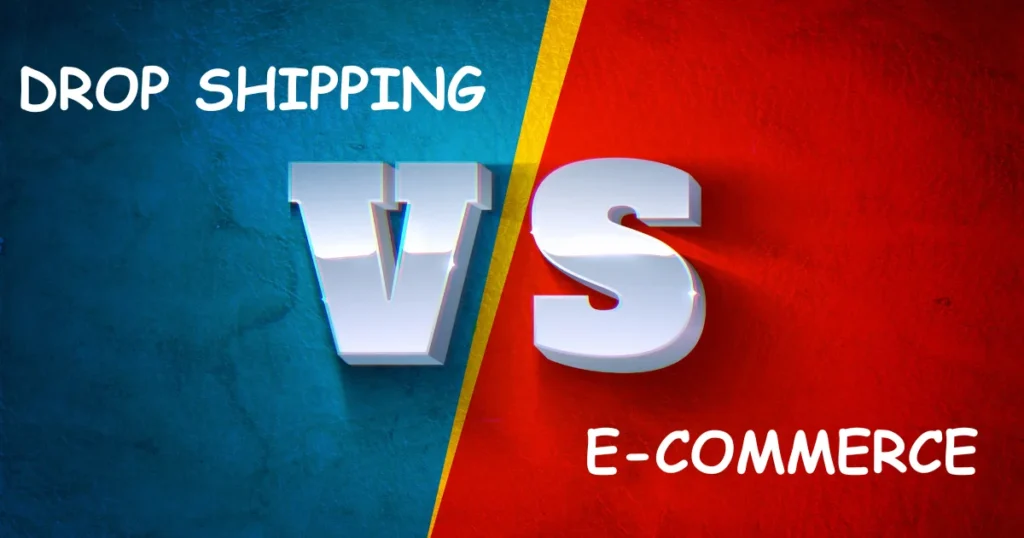Dropshipping vs E-commerce: Which One Suits You Best?
In the realm of online retail, two popular models have emerged as game-changers: dropshipping and traditional e-commerce. Both offer distinct advantages and drawbacks, catering to different business needs and goals. Understanding the nuances between these models is crucial for entrepreneurs looking to establish or expand their online presence.

Dropshipping: Streamlined Retail Without Inventory
Dropshipping has gained widespread popularity for its simplicity and low barrier to entry. In this model, retailers act as intermediaries, facilitating transactions between customers and suppliers without holding inventory. When a customer places an order, the retailer forwards it to the supplier, who then ships the product directly to the customer. Here’s a closer look at the pros and cons of dropshipping:
Pros of Dropshipping:
- Low Initial Investment: Since you don’t need to invest in inventory upfront, dropshipping eliminates the need for significant capital.
- Minimal Risk: Without inventory costs, the risk of unsold products is mitigated, allowing for greater flexibility and experimentation.
- Easy Scalability: Dropshipping simplifies scaling operations as there’s no need to manage physical stock or warehouse logistics.
- Wide Product Range: You can offer a vast array of products without the constraints of physical storage space, appealing to diverse customer preferences.
Cons of Dropshipping:
- Thin Profit Margins: As retailers typically earn a percentage of the sale, profit margins can be slim compared to traditional retail models.
- Dependence on Suppliers: The reputation and reliability of suppliers significantly impact customer satisfaction and business success.
- Limited Control Over Inventory: Since you don’t manage inventory directly, you may encounter issues with stock availability and quality control.
- Increased Competition: The accessibility of dropshipping has led to saturation in certain markets, intensifying competition and driving down margins.
E-commerce: Full Control with Inventory Management
Traditional e-commerce involves owning and managing inventory, providing complete control over the supply chain and customer experience. While it requires a higher initial investment and operational overhead, e-commerce offers unique advantages for businesses looking to establish a brand identity and optimize profit margins. Let’s explore the pros and cons:
Pros of E-commerce:
- Brand Control: Owning inventory allows for greater control over branding, packaging, and customer experience, fostering brand loyalty and recognition.
- Higher Profit Margins: By purchasing products at wholesale prices and selling them at retail prices, e-commerce businesses can enjoy higher profit margins compared to dropshipping.
- Inventory Management: Direct control over inventory enables businesses to optimize stock levels, respond to demand fluctuations, and ensure product quality.
- Diverse Revenue Streams: E-commerce businesses can leverage various sales channels, including their website, third-party platforms, and brick-and-mortar stores, to maximize revenue opportunities.
Cons of E-commerce:
- High Initial Investment: Acquiring and managing inventory requires a significant upfront investment in purchasing, storage, and logistics.
- Inventory Risks: Holding inventory entails the risk of overstocking, obsolete products, and storage costs, necessitating efficient inventory management practices.
- Logistical Challenges: Fulfillment and shipping logistics can be complex and costly, particularly for businesses operating on a large scale or serving international markets.
- Market Saturation: Established e-commerce markets are highly competitive, requiring strategic differentiation and marketing efforts to stand out amidst competitors.
Side-by-Side Comparison:
| Aspect | Dropshipping | E-commerce |
|---|---|---|
| Initial Investment | Low | High |
| Inventory Management | Minimal, no inventory | Direct control, inventory management required |
| Profit Margins | Lower due to commission and competition | Higher due to wholesale pricing and brand control |
| Scalability | Easily scalable without inventory constraints | Scalable with proper infrastructure and logistics |
| Control | Limited control over inventory and fulfillment | Full control over branding, packaging, and fulfillment |
| Risk Management | Lower risk of unsold inventory, but supplier dependence | Risk of overstocking, obsolete products, and storage costs |
Determining the Best Choice for Your Business
When it comes to selecting between dropshipping and traditional e-commerce, there’s no one-size-fits-all answer. The optimal choice depends on various factors unique to your business, including your budget, resources, goals, and risk tolerance. Here’s a detailed breakdown to help you determine which model aligns best with your specific needs:

1. Budget and Initial Investment:
Consider your available capital and willingness to invest upfront. Dropshipping requires minimal initial investment since you don’t need to purchase inventory in bulk.
On the other hand, traditional e-commerce necessitates a higher initial investment for acquiring inventory, storage facilities, and operational infrastructure. If you’re operating on a shoestring budget and prefer a low-risk entry into online retail, dropshipping might be the more suitable option.
2. Risk Tolerance:
Assess your tolerance for risk and your ability to navigate uncertainties in the market. Dropshipping minimizes the risk of unsold inventory since you only purchase products after receiving orders. However, it comes with its own set of risks, such as supplier reliability and product quality control.
Conversely, e-commerce involves greater inventory risk, including overstocking, obsolete products, and storage costs. If you’re risk-averse and prioritize stability, dropshipping may offer a safer bet.
3. Control and Branding:
Consider how much control you want over your business operations and branding. Dropshipping limits your control over inventory management, fulfillment, and branding since you rely on third-party suppliers.
In contrast, e-commerce provides full control over branding, packaging, and customer experience, allowing you to build a distinct brand identity and foster customer loyalty. If brand control and customization are paramount to your business strategy, e-commerce offers a more suitable platform.
4. Profit Margins and Scalability:
Evaluate your profit margin expectations and scalability goals. Dropshipping typically yields lower profit margins due to commissions and intense competition in the market. However, it offers easy scalability without the constraints of inventory management.
On the other hand, e-commerce enables higher profit margins through wholesale pricing and brand control, albeit with higher initial investment and operational complexities. If you prioritize scalability and are willing to invest in infrastructure for long-term growth, e-commerce may be the preferred option.
5. Market Competition and Differentiation:
Analyze the competitive landscape in your niche and your ability to differentiate your offerings. Dropshipping markets are often saturated, making it challenging to stand out amidst competitors.
Conversely, e-commerce markets also face stiff competition but provide opportunities for strategic differentiation through branding, product selection, and customer experience. If you have a unique value proposition and the resources to differentiate your brand effectively, e-commerce offers greater potential for success in competitive markets.
In The End:
Choosing dropshipping vs e-commerce requires careful consideration of your business objectives, resources, and market dynamics. While dropshipping offers low barriers to entry and minimal upfront investment, e-commerce provides greater control, branding opportunities, and potential for higher profit margins.
Ultimately, the best choice depends on your specific circumstances and long-term goals. By weighing the pros and cons of each model and aligning them with your business priorities, you can make an informed decision that sets you on the path to online retail success.






